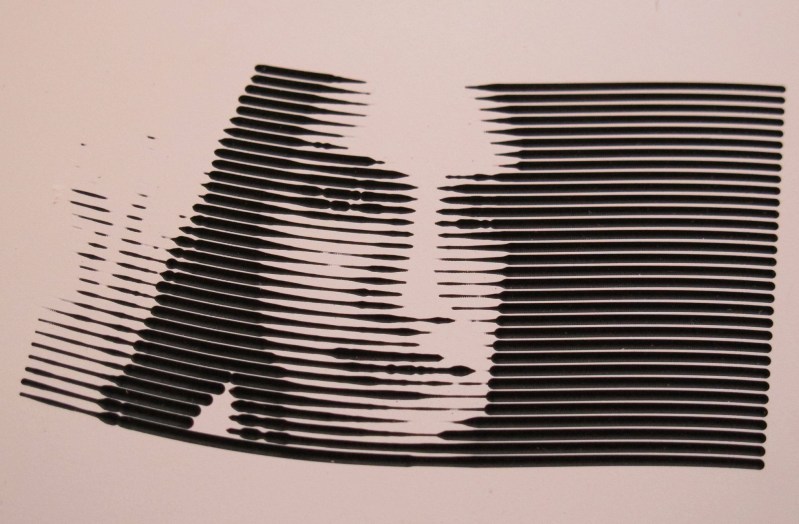Looking for an awesome way to mill out a photo or graphic? Check out [Matt Venn]’s halftone gcode generator which creates halftone CNC toolpaths from any image file. We’ve run across some halftone generators before, but [Matt]’s generator has some interesting features and makes for some pretty unique output.
[Matt] initially wrote a simple command line program in Python, but just rewrote his script with a more user-friendly UI that renders a preview of the output as you change options. The UI lets you change parameters like drill depth, number of lines, and the step size to tweak the output. It even has an option to map the halftone points along a sine wave which makes an interesting effect as shown in the image above.
[Matt]’s program generates standard gcode that you can use to run your CNC machine. [Matt] recommends milling a material with layers of different colors, but you can always mill a solid material and fill the routed areas with paint or dye instead. Want to grab the script or check out the source code? Head over to [Matt]’s GitHub repository.
Thanks for the tip, [Keith O].















ill have to try it out, just built mini cnc unlimited(10inch conveyor x , 2.5inch y,
.75 inch z
with 0.74 inch backlash
I did some halftone experiments in MATLAB a few years ago using a non-square grid. I printed a few really big at Staples using their B&W engineering print service, which turned out pretty good, and only cost a few dollars.
Here are some samples:
http://flic.kr/p/r2gVgR
http://flic.kr/p/r4b8AT
If anyone is interested, I can probably post the code.
Hi will,
could you please send me the code?
thanks
Nick,
Here is the code I used. I need to reinstall MATLAB, so it hasn’t been tested in a while.
Also, I’m not sure if there are rules around here about taking up space in comments and pasting code. Sorry if this is frowned on (it is an old post…).
%Script 1:
clear
% Will Hobbs. 2012.
% Ideas from:
%http://g-fav.blogspot.com/2008/09/math-art-click-stand-back-and-squint.htm
%l
img=imread(‘thefam.jpg’); %Change this. Image to be used.
rowSpacing=16; %Change this. Vertical spacing (pixels).
colSpacing=8; %Change this. Horizontal spacing (pixels).
areaExponent=1.3; %Change this. Higher number gives more contrast?
imgGR=rgb2gray(img);
%imgGR=histeq(imgGR);
startRow=1;
startCol=1;
numRows=size(imgGR,1);
numCols=size(imgGR,2);
for i=1:numRows/rowSpacing-1
for j=1:numCols/colSpacing-1
dotDiam(i,j)=256-mean2(imgGR(startRow:startRow+rowSpacing-1,startCol:startCol+colSpacing-1));
x(i,j)=j;
y(i,j)=i;
startCol=startCol+colSpacing;
end
startCol=1;
startRow=startRow+rowSpacing;
end
dotArea=(dotDiam./2).^areaExponent*pi;
scatter(reshape(x,1,[]),-reshape(y,1,[]),reshape(dotArea/20,1,[]),’filled’,’k’)
set(gca,’Visible’,’off’)
set(gcf,’color’,’w’)
daspect([rowSpacing colSpacing 1])
%—————
%Script 2:
clear
% Will Hobbs. 2012.
% Ideas and some code from:
%http://g-fav.blogspot.com/2008/09/math-art-click-stand-back-and-squint.htm
%l
%http://www.mathworks.com/matlabcentral/newsreader/view_thread/300190
face=imread(‘IMG_9735.jpg’);
faceGR=rgb2gray(face);
%faceGR=histeq(faceGR);
%————————-
%Concentric Circles
numRows=size(faceGR,1);
numCols=size(faceGR,2);
diag=round(sqrt(numRows^2+numCols^2));
sp=12; %even number. CHANGE THIS
for r=1:sp:(diag)
x1=(-r:r)’;
x2=(-r:r)’;
y1=sqrt(r^2-x1.^2);
y2=-sqrt(r^2-x2.^2);
dxy1=diff([x1,y1],1);
dxy2=diff([x2,y2],1);
d=sqrt(sum(dxy1.^2,2));
d=[0; cumsum(d)];
di=linspace(0,d(end),pi*r/14);
xyi1=interp1(d,[x1,y1],di);
xi1=xyi1(:,1);
yi1=xyi1(:,2);
xyi2=interp1(d,[x2,y2],di);
xi2=xyi2(:,1);
yi2=xyi2(:,2);
if r>1
Xi=[Xi;xi1;xi2];
Yi=[Yi;yi1;yi2];
else
Xi=[xi1;xi2];
Yi=[yi1;yi2];
end
end
%————————-
% %————————-
% %Sine Waves
% numRows=size(faceGR,1);
% numCols=size(faceGR,2);
% diag=round(sqrt(numRows^2+numCols^2));
% sp=18; %even number. CHANGE THIS
% spH=.5; % CHANGE THIS
% for r=1:sp:numRows
% x1=(1:spH:numCols)’;
% y1=5*sin(x1/40)+r; % these values can be changed
%
% if r>1
% Xi=[Xi;x1];
% Yi=[Yi;y1];
% else
% Xi=[x1];
% Yi=[y1];
% end
% end
% %————————-
XY=[Xi,Yi];
rowStart=-100;
colStart=-80;
XY2=XY(XY(:,1)>(colStart+sp)&XY(:,1)<(numCols+colStart-sp)&XY(:,2)(-rowStart+sp-numRows),:);
Xi=numCols-(XY2(:,1)-colStart);
Yi=XY2(:,2)+numRows+rowStart;
for i=1:length(Xi)
row=numRows-round(Yi(i));
col=numCols-round(Xi(i));
dotDiam2(i)=double(256-mean2(faceGR(row-sp/2:row+sp/2,col-sp/2:col+sp/2)));
dotArea2(i)=(dotDiam2(i)./2).^1.9*pi; %CHANGE THIS. The exponent can be changed.
end
figure
scatter(-Xi,Yi,dotArea2/100,’filled’,’k’)
axis equal
axis([-numCols+sp,-sp,sp,numRows-sp])
set(gca,’Visible’,’off’)
set(gcf,’color’,’w’)
could you please send it for me
mehdirezaeian56@gmail.com
Woot! Shameless-self-promo-thread!
https://sites.google.com/site/geekattempts/_/rsrc/1388376248439/old-projects/100_3956_small.jpg
It’s just a sine-wave whose frequency increases for dark and goes DC for light… Never thought of CNCing it, might be cool… Or watch as ink slowly travels the path…
That’s really awesome… reminds me of an EKG or seismograph printout
That would be a great use of a 2-axis mirror galvo, a UV laser and a “glow-in-the-dark” painted wall! (Except you’d have to invert the light/dark frequency thing)
Very cool concept!!! Never thought of using something like MATLAB to transform the image into half-tone.
Mmmm – I’m trying to send a comment about a real live 9 meter tall half-tone image made of steel, with some links, but the comment never shows up here. If I try send it again, it says I’ve duplicated my comment. @Ethan Zonca maybe you can see it. Any ideas why?
… trying to send the comment in parts to see where it gets rejected:
Readers may be interested in a unique massive half-tone image in tribute to Nelson Mandela, made out of 50 steel columns varying in thickness, in the KwaZulu Natal province in South Africa. The tallest column is over 9 meters high, and when viewed from the “focus”, it shows a clear half-tone image of Mr. Mandela’s likeness.
This guy’s done a nice post on his blog with photos:
http://www.fotoman.co.za/blog/nelson-mandela-capture-site/
Here’s something about how it was made, as well as an animation:
http://project1.artright.co.za/release-marco-cianfanelli/
Hackaday has something against this link. Please remove the spaces or hack hackaday:
h t t p : / / w w w . p a r t s a n d l a b o u r . c o . z a / p o r t f o l i o / n e l s o n – m a n d e l a – c a p t u r e – s i t e /
I’ve been there, and it’s quite satisfying when all the columns line up.
For the record, I have no p o l i t i c a l affiliations – this is purely for interest
Crayzeee. @daveboltman HAD has some serious problems with that .za domain I think… I just tried to post a link to the same ..partsandlabour… and it vanished… lets see if I can sneak this one under the eyes of the gremlins…
http://www.partsandlabour.co.za/wp-content/uploads/2013/01/Release-Nelson-Mandela-Capture-Site-Project-Management-640×350.jpg
Nice one, tx @andrewjhull, that’s it
It’s looks like this when you’re standing somewhere else
http://www.fotoman.co.za/wp-content/uploads/2013/05/JLDFP_20130512_00172.jpg
(with credit to http://www.fotoman.co.za)
Thanks for sharing. Keep up the good work